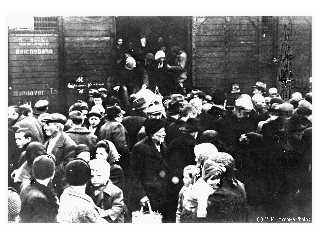



 The entire gypsy camp at Auschwitz, of 4000 people, was exterminated
on August 1, 1944:
The entire gypsy camp at Auschwitz, of 4000 people, was exterminated
on August 1, 1944:Set up as a family camp, the Gypsy unit rapidly deteriorated and became extraordinarily filthy and unhygienic even for Auschwitz, a place of starving babies, children and adults. B. insisted that there were "sufficient rations...delivered to the camp for all of them to survive", but that certain adult Gypsies of high standing kept most of the food, thus denying it to all others, including hungry children. The Auschwitz leaders, "shocked" by the situation, came to the conclusion that it was virtually impossible to change it and that the only solution was to "gas the entire camp." According to B., Mengele strongly opposed that decision, made several trips to Berlin to try and get it reversed, and went so far as to declare to other Auschwitz authorities that annihilating the Gypsy camp would be "a crime."
[Most other sources agree that Mengele was in favor of killing the Gypsies.]
Prisoner doctors who had worked there at the time told me that Mengele seemed to be all over the camp at once that day, actively supervising arrangements for getting the Gypsies to the gas chamber. He had been close to some of the Gypsy children-- bringing them food and candy, sometimes little toys, and taking them for brief outings. Whenever he appeared, they would greet him warmly with the cry, "Onkel ['Uncle'] Mengele!" But that day, the children were frightened. Dr. Alexander O. described the scene and one child's plea to Mengele:
Mengele arrived at around eight o'clock or seven-thirty. It was day-light. He came, and then the children....A Gypsy girl of eleven, twelve,....the oldest [child] of a whole family--maybe thirteen, with malnutrition sometimes they grow less. "Onkel Mengele [she calls], my little brother cries himself to death. We do not know where our mother is. He cries himself to death, Onkel Mengele!" Where did she go to complain? To Mengele--to the one she loves and knows she is loved by, because he loved them. His answer: "Willst du die Schnauze halten!" He said it in a common, vulgar way....but...with a sort of tenderness..."Why don't you shut your little trap!"
Others told how Mengele combed the blocks, tracking down Gypsy children who had hidden, and how he himself transported a group of those children in a car to the gas chamber--drawing upon their trust for him and speaking tenderly and reassuringly to them until the end.
Lifton, pp. 323; 185-186.
And so one after the other. The one, she was six, was already dead when I came there. I did not see her anymore. Not long after, the other one died too. They were only skin and bones. Skin and bones, nothing else, one could count the ribs. The eyes so deep in the head. The children were dead, all three.
Testimony of a Gypsy woman survivor of the Gypsy family camp, Anatomy, p. 452.
Thus, in an instant, our women, our parents, our children disappeared. We saw them for a short while as an obscure mass at the other end of the platform; then we saw nothing more.
Levi, Survival p. 20.
The three necks were placed at the same moment within the nooses.
"Long live liberty!" cried the two adults.
But the child was silent.
"Where is God? Where is He?" someone behind me asked.
At a sign from the head of the camp, the three chairs tipped over...
Then the march past began. The two adults were no longer alive. Their tongues hung swollen, blue-tinged. But the third rope was still moving; being so light, the child was still alive...
For more than half an hour he stayed there, struggling between life and death, dying in slow agony under our eyes. And we had to look him full in the face. He was still alive when I passed in front of him. His tongue was still red, his eyes were not yet glazed.
Behind me, I heard the same man asking:
"Where is God now?"
And I heard a voice within me answer him:
"Where is He? Here He is--He is hanging here on this gallows..."
That night the soup tasted of corpses.
Wiesel, p. 72.
Immediately after the war, Soviet and Polish commissions reported four million victims of the camp; Camp Commandant Rudolf Hoss testified that three million died there.
It is impossible to ascertain exactly how many people were at Auschwitz for two reasons. First of all, no records were kept of people murdered after selections at the train station; they were never assigned numbers or entered into camp records but vanished into what the Nazis themselves called "night and fog" ("nacht und nebel"). Secondly, the Nazis destroyed many records before abandoning Auschwitz.
Scholars such as Franciszek Piper, writing in Anatomy, pp. 61-76, arrive at their estimates by looking at the more accurate records of people deported to Auschwitz from various countries, and then subtracting the number of people known to have been transferred to other camps or to have survived the war.
Based on these calculations (1,300,000 deportees minus 200,000 survivors), at least 1,100,000 persons were killed or died in the camp.
Piper, p. 71.
Friedrich, 102.
